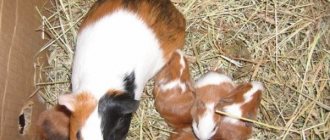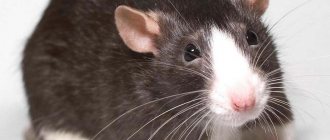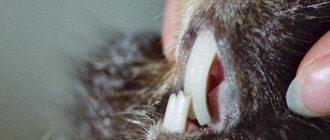When a female dwarf is preparing to give birth, many owners have a lot of questions about what will happen next. How to care for newborn hamsters so that they survive, what to feed them and when to give them to new owners.
It is very important to understand this, because small dwarfs are so helpless and weak that any mistakes in care can result in the death of the brood.
What do newborn hamsters look like?
Newborn hamsters are completely hairless, so they look like a red, swarming mass. Their ears and eyes are closed; only their sense of smell allows them to navigate. Babies may squeak loudly if they are cold or hungry. If the mother takes good care of the offspring, the babies do not make a sound. Sometimes the owner discovers that there are newborn hamsters in the house, by accident - when cleaning the cage, or when grown-up children of hamsters begin to crawl out of the nest.
Newborn hamsters
A baby hamster is no larger than the phalanx of a finger, weighing 1-2.5 g. In the first days, it can be difficult to count the offspring, especially since the female feeds the children, lying on them with her whole body. It is not recommended to look into the house so as not to disturb the hamster.
Although dwarf hamsters are much smaller in size, newborn Syrian hamsters are not very different in size from dwarf hamsters. The fact is that Syrians are multiple: the more children in one litter, the smaller the size of each hamster.
Newborn Hamster Size
How many children does a hamster give birth to?
The reproductive abilities of these rodents have long been the subject of jokes. Their fertility is really high, especially at home, when hamsters do not hibernate and receive an abundance of food. The ability to reproduce rapidly is a quality that makes rodents so popular as laboratory animals.
Hamsters can give birth to a different number of babies depending on the species and conditions of detention. It is quite precisely known how many hamsters are born to Djungarians - from 4 to 6 pieces. Rarely – 8-9 cubs. Due to their size, dwarf hamsters are not as fertile. But having learned how many hamsters a Syrian hamster can give birth to, an amateur breeder sometimes grabs his head. The average number is 6-10 babies, but sometimes there are 16-18, occasionally even 20 pieces.
The number of babies a hamster can give birth to - both the Djungarian and the Syrian - does not correspond to the number that the female is able to feed. Some of the numerous offspring die or are devoured by the mother. Therefore, the number of surviving hamster babies does not exceed 10-12.
How many babies can there be in a litter?
Pregnancy among Djungarians lasts about 3 weeks – 20-21 days. Its duration depends on the number of cubs in the litter. The more there are, the faster they will be born.
Primiparous hamsters bear 4-5 dwarfs. Subsequently, the number of cubs increases to 8-10.
The more newborns in a litter, the less likely they are to survive. In some cases, the female eats the most unviable children. In this way she tries to save the others.
How to care for newborn hamsters
A newborn Djungarian hamster is a helpless creature that is completely dependent on the actions of its mother. Cubs need warmth and food. The temperature in the room is maintained at least 21 C, but not higher than 25 C. If the female takes care of the offspring on her own, the owner will not need to care for the born hamsters.
It is extremely rare to raise babies under 10 days of age without a mother.
At home, caring for cubs comes down to caring for their mother. In the case of rodents, the best help is to stay out of the way. The female and children need privacy. Baby Djungarian hamsters will be in mortal danger if their mother is stressed.
Host actions:
Feeding
Usually the owner feeds the hamster, and the hamster feeds its babies. The female must be provided with plenty of water and food, including a source of protein and succulent food. If the mother has enough milk, there is no need to feed the cubs. You can throw grated carrots, low-fat cottage cheese and other foods into the baby’s nest if the hamster does not do this. Food is placed in the cage with the expectation that any product can be tasted by Djungarian babies.
Arrangement of the cage:
- Litter.
It's good if there is a house in the cage. If it is not there, you need to put a small cardboard box. If the female is provided with materials for construction, she will cope with the arrangement of the home herself. In addition to sawdust or other filler, paper towels are placed in the cage. It is forbidden to use cotton wool or rags; these materials are dangerous for baby hamsters (they can get entangled and suffocate). General cleaning is not carried out for at least 2 weeks.
- Safety.
Sometimes, even with a caring mother, the question arises - what to do with newborn hamsters that have fallen out of the nest. To prevent the baby from freezing or catching a cold, it is better to return him to his brothers and sisters. But not with your hand, but with a spoon on a long handle.
At 10-12 days, a newborn hamster begins to explore the world around him; he cannot be kept in the nest. There should be no differences in height (tiers) in the cage; pay attention to the distance between the bars (whether the baby will fall out). Do not place water in an open bowl. Feeders are placed so that they are accessible to babies.
Injuries at 3-4 weeks of age are possible in the running wheel. It is interesting to watch young Djungarian hamsters during games, but in this case the wheel should not stand on a stand (hang on the wall) and be solid, without crossbars.
- Privacy.
The cage should be in a quiet place so that no loud noises can be heard. It is protected from the sun's rays. Drafts are not allowed. Children are explained that caring for small hamsters takes up all their free time, and they cannot pick them up for play for 2-3 weeks.
When the animals grow up and are placed in other cages, caring for dwarf animals includes daily hand training. Otherwise, they may bite the hands of the new owner. Syrians are more friendly, but detailed instructions on how to care for a small hamster will be useful.
Human and hamster years: how to compare
If we compare human and hamster life years, provided that the average life expectancy of a human is 60-70 years, and that of a hamster is 2-3 years, we obtain the following ratio of their years:
- a hamster 15 days old can be equated to a child 8-10 months old;
- a six-month-old hamster - to a teenager 12-14 years old;
- a two-year-old hamster - to a person aged 50-60 years;
- a three-year-old hamster - to a person aged 70-80 years.
How do hamsters grow?
The reproduction of Djungarian hamsters, like the reproduction of Syrian hamsters, occurs extremely intensively. Hamsters and their babies are the embodiment of rapid development. First, the fetuses gain weight in the womb in a matter of days, and then continue to grow just as quickly after birth.
A day after birth, red, naked babies turn pink or darken, depending on the color of the fur that has broken through. By day 4, you can distinguish the color of dark hamsters; light ones look pink, but not hairless.
Newborn hamsters are 4 days old
A newborn hamster is a rather helpless creature. All they can do is squeak and move their paws. They find the mother's nipple by smell. On days 5-6, the cubs' ears protrude and they begin to hear.
Hamsters grow very quickly. At the age of 1 week, babies are already covered with fluff and begin to try solid food. Like true rodents, they were equipped with sharp teeth from the first day of life. The first food after mother's milk is often your own feces. Coprophagia is a natural process necessary to populate the intestines with the correct microflora. The babies also try the food brought by the female to the house.
Syrian or golden hamster
Behavioral differences
Young Syrian hamsters, like the Djungarians, are active, very active, curious about the world around them, love to play or run in a wheel, and like to stay awake at night. Sometimes they can be a little aggressive. At an older age, they become calmer and more sedentary.
Hair in the ear area
When examining a hamster, you need to pay attention to the condition of the fur near its ears and in the parotid area. In young hamsters, these parts are covered with an even, thin layer of white and fluffy hair. In older individuals, the ears are almost bare, and the remaining hairs on the ears grow noticeably.
Eyes
Young Syrian hamsters have black eyes, slightly bulging and slightly shiny. In healthy hamsters, the mucous membrane of the eyelids is pink and slightly moist.
If the eyes of Syrian hamsters are very shiny, have changed color, are covered with a yellowish film, are sunken, have popped out of their sockets, are dry or very moist, and the mucous membrane of the eyelids is inflamed - this indicates old age or illness of the hamster.
Wool
Syrian hamsters come in short-haired and long-haired varieties.
Long-haired dogs can also be “satin”. Their fur has a satiny sheen.
As they age, the color of Syrian hamsters darkens.
Golden rodents have gray small ears and black bangs. They have this coat color up to 8 months from birth. After 8 months of residence, their undercoats turn gray, but the upper hairs remain golden.
Smoky-pearl colored hamsters have gray fur and beige undercoats. As they get older, their coats may lighten. This is due to a varied diet at home.
Yellow-brown rodents have a rich honey-colored coat. The yellow tint takes up 30% of the total color. A distinctive feature is that these individuals retain their coat color throughout their lives.
Young animals have soft, thick and bright fur, but after two years it becomes hard and sparse.
Weight
The weight of a newborn Syrian hamster is 2-4 grams, and an adult – 100-125 grams. Moreover, their growth in length can reach 13 – 13.5 centimeters.
Dark spots
After one year of life, Syrian hamsters develop black spots on their bodies. They may be on the left and right lower back, as well as around the genitals, or the skin may darken in one patch. These are their glands that darken and become bulging with age.
Lifespan
Syrian hamsters live on average 3 years. If a rodent is provided with good care, it can live for 4 years. Because The average life expectancy of animals is 2 years; Syrian hamsters are classified as long-livers.
Young people are always active and playful
When can you handle newborn hamsters?
During the first two weeks after the birth of the offspring, it is not recommended to stick your hand into the cage, even to leave food. Cleaning the cage is prohibited. Touching newborn hamsters means putting their lives at risk .
The female can eat the cubs by smelling someone else's scent.
No matter how much curiosity there is, there is no need to pick up or stroke babies. Sometimes droppings are weighed for scientific purposes, or a dropped baby needs to be returned to the nest. Then the animal is taken not with the hand, but with a spoon or other suitable object. If you still need to pick it up, you need to use latex gloves and dump the baby in the toilet corner before returning it to the mother.
Babies begin to get used to being handled at the age when they can already survive without the care of a female, that is, no earlier than 2 weeks. In order not to count down the days until the moment when you can meet the hamsters, you need to focus on opening your eyes (do not touch blind children).
The age of 14-21 days is the optimal time for the first acquaintance.
Complications after COVID-19: how to treat cough after coronavirus?
Patients who have recovered from COVID-19 develop antibodies that prevent reinfection.
However, there is no guarantee how long immunity from antibodies will last. There have been cases where the patient became re-infected. In addition, people experience lingering effects of the disease. For example, an irritating and painful dry cough. Moreover, many patients suffer so much that they no longer know how to treat this lingering cough.
Research shows that the lungs are usually the most affected organ after COVID-19. After recovery, you may continue to have a dry or wet cough.
Recovery process after COVID-19
According to the US Centers for Disease Control and Prevention, patients with mild to moderate severity of the virus recover within 10 days. Patients with severe and critical illness require up to 20 days to recover.
Returning to your normal lifestyle depends on the degree of damage to the lungs and their tissues. For those who suffered from chronic diseases before COVID-19, this period becomes longer.
While you are recovering from COVID-19, you may still have a dry cough for some time. In online surveys, cough was reported in 20–30% of patients. Symptoms persisted 2–3 months after the onset of COVID-19. Over time, the cough may get worse. At the same time, excessive coughing causes irritation and inflammation, which aggravates the debilitating cough.
Because your immune system is especially vulnerable during the recovery period, you must be careful to ensure a full recovery.
When can you give away hamsters after birth?
Hamsters cannot be given away immediately after weaning. They are divided into two groups by gender and placed in separate cages. This should be a full-fledged home with a drinking bowl, a house, a wheel and other toys. The cage for dwarf hamsters should be no smaller in size than for Syrian hamsters.
When the female relinquishes her responsibility for caring for the children, the owner’s troubles increase. It is not surprising that people are interested in at what age young animals can be given away. Moving to a new home is a lot of stress for Djungarian babies. It is optimal to distribute them at the age of 1.5-2 months, i.e. 6-8 weeks.
As a rule, breeders try to give away animals early. After all, at 7-8 weeks fights for territory may begin, and each young hamster will need to be provided with an individual cage. In a good nursery, the grown rodents are resistant to disease and are accustomed to handling. Along with the hamster, you should give some used litter and food for several days. A familiar smell and familiar diet reduce the stress of moving.
All the most important things about breeding Djungarian hamsters at home
All these products are given separately and on different days, not all at once. For example, on Tuesday boiled chicken, on Thursday a little chicken. Hamster food, succulent food, is given daily. The chicken should be cooked without any seasonings, without salt.
Pregnancy and childbirth in hamsters - https://msvinka.ru/hom2.html
Creation time: 03 March 2011 11:19
| Rate the answer Excellent Good Satisfactory Not satisfactory Very bad Ratings: 4 |
Opinion of the audience Vladimir
03.03.2011 09:34
| well, I already wrote about nutrition - before the birth, a couple of days before the birth, the male was placed separately from the cage - now they are separately... the cage is three-story - on the ground floor there is a house, a feeding trough, a drinking bowl ... the bottom is sprinkled with chips, they brought napkins into the house earlier) )..on the second floor there is also a house, and from the second to the third floor there is a spiral - on the third floor there are two wheels...well, in principle, I described everything |
Bachilo Svetlana
03.03.2011 21:03
| Ahha. When the kids grow up, the spiral can become unsafe - it’s easy to get your paw stuck there, especially when a crowd is running along the spiral at once. Keep an eye on children; the coil may need to be removed. Do the wheels have a solid or lattice running surface? |
Ask a new question in the consultation “Rodents/Feeding and Dietetics”
What to feed a baby hamster
Newborns
If the cubs are left without a mother, or the female does not have milk, the owner can feed them. The task is not easy: small hamsters need to be fed every 1.5 hours. Use soy-based infant formula 0+, dissolving and heating according to instructions. Sometimes they take Royal Canin cat milk replacer.
Each baby is fed individually from a pipette or insulin syringe without a needle. To prevent the animal from choking, it is held in a column, and milk is poured in small portions. It is advisable to massage the tummy after each feeding, monitor the presence of stool, and keep it warm.
Most hamsters die if their mother does not feed them, even when the breeder makes every effort to preserve the offspring. The reasons are different - aspiration pneumonia when milk gets into the respiratory tract, infections (the mixture does not contain maternal antibodies and does not provide strong immunity).
Hamster feeding
Babies have a greater chance of survival if they manage to find an adoptive mother - a female who has recently given birth and has a small litter. The babies are rolled around in the hamster’s toilet corner, then mixed with the “native” hamsters.
Age 1-3 weeks
When artificially feeding offspring, the sooner the hamsters start eating themselves, the better. After just a few days, the milk mixture is mixed with ground grain feed and vegetable purees are given.
Vegetable puree for babies
At 1.5 weeks of age, small hamsters can eat solid food and their chances of survival increase dramatically. Sprouted wheat, oats, a boiled egg, grated carrots and other vegetables are placed in the feeder every day. From 2 weeks of age, small hamsters need to be fed every 4 hours (6 times a day). The mixture and ground food are mixed until a paste of creamy consistency is obtained.
For both dwarf and Syrian hamsters, when feeding young animals, you need to focus on the list of permitted products. If the babies are raised by their mother, she carries her food into the nest, so they learn what the adults eat.
Dry cough
A dry cough is a cough in which no mucus or phlegm is produced from the respiratory tract.
With a dry cough, a person may feel a dry, scratchy, sore, or scratchy throat. You may also experience a tickling or dry throat sensation even when swallowing, Medical News Today reports.
A dry cough may not bring relief even after clearing the throat. Instead, the cough causes an even bigger coughing fit. This video shows how we cough:
SARS-CoV‑2, the virus that causes COVID-19, is a respiratory illness that usually causes a dry cough. A dry cough is a common early symptom of COVID-19. It is estimated that in 60-70% of people who develop symptoms of COVID-19, a dry cough is the initial symptom.
However, dry cough can also be caused by some other diseases. Dr. and professor Debra Rose Wilson tells Healthline. Among these diseases:
- asthma,
- idiopathic pulmonary fibrosis,
- gastroesophageal reflux disease,
- upper respiratory tract infections,
- lungs' cancer.
A dry cough accompanied by other symptoms may indicate COVID-19.
These associated symptoms include:
- headache
- muscle or joint pain
- a sore throat
- runny or stuffy nose
- diarrhea
- nausea or vomiting
- shortness of breath or difficulty breathing
In addition, symptoms include:
- loss of taste and smell
- loss of appetite
- unexplained or unusual exhaustion
- high temperature
A 2021 study in Wuhan, China, found that most people with COVID-19 developed a dry cough within 1 day of illness. Moreover, the cough lasted approximately 19 days. In approximately 5% of study participants, cough persisted for 4 weeks.











